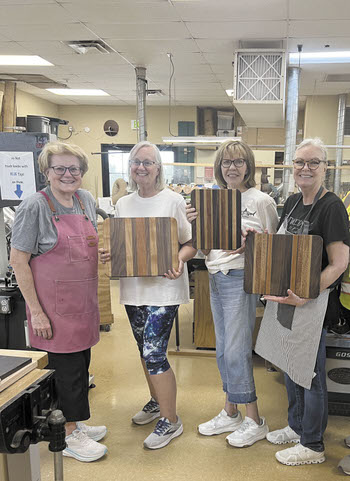
Left to right: Instructor Teresa McGill with Nancy Spaulding, Becky Linke, and Tammy Quapaw who are showing off their cutting boards
Lorraine Wilson
There’s something big happening in the woodshop at the CATC building—a dynamic, ongoing process that fuels everything from small personal projects to large, impressive builds. Members of the shop are well aware of it. For non-members, however, it goes mostly unnoticed. It’s not just about tools or techniques. The real engine behind the woodshop is collaboration.
While collaboration is present in many of the clubs throughout CATC, it’s especially visible in the woodshop. And it’s only through becoming a member that one can fully experience how essential this element is. Walk into the shop on any day and you’ll likely see people working together—sharing knowledge, solving problems, and offering a hand or some advice. It’s part of the fabric of the place.
Collaboration, in its most basic form, is when two or more people work together toward a shared goal. It means exchanging ideas, offering help, and using each person’s strengths to create something better than what could be done alone.
Last month’s article highlighted the woodshop’s equipment training classes. These classes themselves are a form of collaboration—members coming together to teach, to learn, and to grow in their skills. The same spirit carries through daily, as experienced woodworkers offer guidance to others. If someone has a question, a fellow member is ready with an answer. If someone gets stuck on a project, help is never far away. And if someone isn’t sure what to make next, inspiration is all around—watching others work often leads to new ideas.
Collaboration becomes even more evident during large-scale projects. Recently, Frank Cianci completed a maple table that started with a prototype built from pine. Throughout the process, other woodworkers assisted Frank, or simply watched the project come together, learning in the process. A photo captured Wayne Caudill, Dave Popejoy, Frank Cianci, and Larry Daniels discussing how to glue the tabletop—an everyday example of the teamwork that defines the woodshop.
This spirit of working together also showed up in two recent classes. The Antique Post Office Box Bank class, taught by Boyce Irwin, Jack Ackerman, and Scott Lebsack, brought intermediate woodworkers together to create cherry wood boxes with genuine post office doors. Participants didn’t just learn from instructors—they learned from each other.
Likewise, the beginner Cutting Board class was a success, with seven participants each creating their own board from mahogany, maple, walnut, oak, and cherry woods. Instructors Teresa McGill, Michelle Crissey, and Lorraine Wilson coordinated closely to lead the class. It was their first time teaching, and they worked as a team to guide the new woodworkers through the process—from cutting rough boards with the compound miter saw to shaping the boards with jointers, planers, bandsaws, and table saws.
The woodshop’s success isn’t just about individual talent. It’s built on a foundation of shared knowledge, mutual respect, and a willingness to work together. Collaboration isn’t just a secret—it’s the strength of the woodshop.
